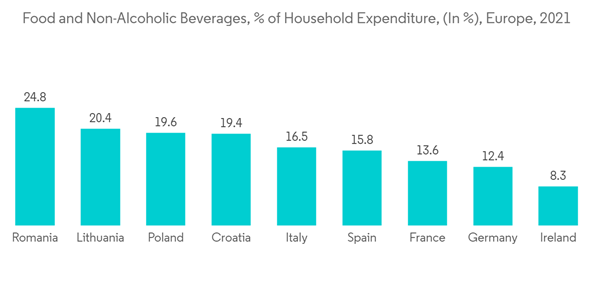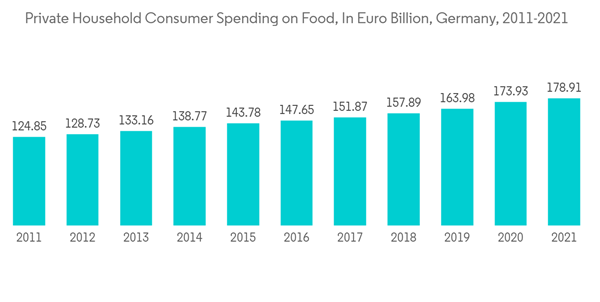The COVID-19 pandemic, which resulted in nationwide lockdowns, disruptions in manufacturing activity and supply chains, and production halts, had a severe influence on the market in 2020. However, in 2021, conditions began to improve, resuming the market's growth trajectory for the projection period.
Key Highlights
- The increasing demand for packed foods from the food and beverage industry and the rapidly growing e-commerce industry is likely to drive the demand for the market.
- On the flip side, increasing government regulations and the availability of substitutes like linerless labels are hindering market growth.
- Shifting focus toward bio-based self-adhesive labels is forecasted to offer various market growth opportunities over the forecast period.
- Germany represents the largest market and is also expected to be the fastest-growing market over the forecast period owing to the increasing consumption from food and beverage industries in coming years.
Europe Self Adhesives Label Market Trends
Increasing Demand for Packed Foods from Food and Beverage Industry
- Self-adhesive labels are well known for enhancing the visual appeal of food and beverage packaging. Self-adhesive labels play a significant role in the authentication and tamper-evidence of products in food and beverage packaging.
- Self-adhesive labels are a popular choice due to their incredibly stable nature, which aids in increasing consumer awareness of product information. Labels communicate how to use, transport, recycle, and /or dispose of the package or product.
- With substantial growth in the food and beverage industry and demand for packaged food goods across the region, there is a surge in the usage of labels used in food and beverage product packaging.
- According to the FoodDrink Europe report, in 2021, the European Union food and drink industry generated a turnover of about USD 1.1 trillion and USD 230 billion in value-added to GDP, making it one of the largest manufacturing industries in the EU.
- The report also stated that The European Union is the world's greatest exporter of food and beverages, with exports outside the EU totaling EUR 156 billion (~USD 166 billion) and a trade surplus of EUR 73 billion (~USD 78 billion).
- A Eurostat report also stated that EU households spent over EUR 1,035 billion (~USD 1106 billion) (equivalent to 7.1% of the total EU GDP) on 'Food and non-alcoholic beverages' during the year 2021. It represents 14.3% of total household expenditure compared with 2020 (14.8% share).
- As customers seek healthier beverages to consume on the move, the food and beverage business is fast evolving, with a consistently growing market for energy and sports drinks, tea, coffee, and bottled water.
- Hence, owing to the factors above, the application of self-adhesive labels from the food and beverage industry will likely dominate during the forecast period.
Germany to Dominate the Market
- Germany’s food and beverage industry is the fourth-largest in terms of future growth possibilities. The industry is characterized by its small and medium-sized enterprise sectors of about 6,000 companies.
- Food Export Association of the Midwest USA and Food Export USA-Northeast, in their report, mentioned a total of approximately USD 115 billion was being generated from the retail sales in the packaged food market in Germany in 2022. That represents a growth of 11.2% or USD 11.5 billion since 2018.
- Germany is the 4th largest packaged food market in the world. By 2026, retail sales in the packaged food market in Germany are expected to reach USD 127.1 billion, a growth of 10.6% or USD 12.1 billion from 2022.
- The report by the food export organization also mentioned that a total of USD 201 billion of processed food and drinks was being produced in Germany in 2021.
- Self-adhesive labels are commonly used in packaging medications and medical equipment imported or exported to various nations. According to the International Trade Administration, the market size of German medical equipment in 2021 was approximately USD 39 billion and is expected to increase to close to USD 42 billion, representing a 7% increase over the previous year.
- The growing demand for value and quality-enriched products, including organic, fair trade, and health and wellness goods in Germany, indicates good potential demand for self-adhesive labels.
- Owing to the factors above, the market for self-adhesive labels in Germany is projected to grow significantly during the study period.
Europe Self Adhesives Label Market Competitor Analysis
The European self-adhesive label market is partially consolidated, with only a few major players dominating the market. Some of the major companies are (not in a particular order) Fuji Seal International, Inc., H.B. Fuller Company, LINTEC Corporation, ThaiKK Co., Ltd., and UPM.Additional benefits of purchasing the report:
- The market estimate (ME) sheet in Excel format
- 3 months of analyst support
This product will be delivered within 2 business days.
Table of Contents
1 INTRODUCTION1.1 Study Assumptions
1.2 Scope of the Study
2 RESEARCH METHODOLOGY
3 EXECUTIVE SUMMARY
4 MARKET DYNAMICS
4.1 Drivers
4.1.1 Increasing Demand for Packed Foods from Food and Beverage Industry
4.1.2 Rapidly Growing E-commerce Industry
4.2 Restraints
4.2.1 Increasing Government Regulations
4.2.2 Availability of Substitutes like Linerless Labels
4.3 Industry Value Chain Analysis
4.4 Porter's Five Forces Analysis
4.4.1 Bargaining Power of Suppliers
4.4.2 Bargaining Power of Buyers
4.4.3 Threat of New Entrants
4.4.4 Threat of Substitute Products
4.4.5 Degree of Competition
5 MARKET SEGMENTATION (Market Size in Value)
5.1 Adhesive Type
5.1.1 Water-based
5.1.2 Hot-melt
5.1.3 Rubber adhesives
5.1.4 Acrylic
5.2 Face Material
5.2.1 Paper
5.2.2 Plastic
5.2.2.1 Polypropylene
5.2.2.2 Polyester
5.2.2.3 Vinyl
5.2.2.4 Other Plastics
5.3 Application
5.3.1 Food and Beverage
5.3.2 Pharmaceutical
5.3.3 Logistics and Transport
5.3.4 Personal Care
5.3.5 Consumer Durables
5.3.6 Other Applications
5.4 Geography
5.4.1 Germany
5.4.2 United Kingdom
5.4.3 France
5.4.4 Italy
5.4.5 Rest of Europe
6 COMPETITIVE LANDSCAPE
6.1 Mergers and Acquisitions, Joint Ventures, Collaborations, and Agreements
6.2 Market Share (%)**/Ranking Analysis
6.3 Strategies Adopted by Leading Players
6.4 Company Profiles
6.4.1 Avery Dennison Corporation
6.4.2 Fuji Seal International, Inc.
6.4.3 H.B. Fuller Company
6.4.4 Lecta Adestor
6.4.5 LINTEC Corporation
6.4.6 Mondi
6.4.7 ThaiKK Co. Ltd.
6.4.8 UPM
7 MARKET OPPORTUNITIES AND FUTURE TRENDS
7.1 Shifting Focus Toward Bio-Based Self-Adhesive Labels
Companies Mentioned (Partial List)
A selection of companies mentioned in this report includes, but is not limited to:
- Avery Dennison Corporation
- Fuji Seal International, Inc.
- H.B. Fuller Company
- Lecta Adestor
- LINTEC Corporation
- Mondi
- ThaiKK Co., Ltd.
- UPM










